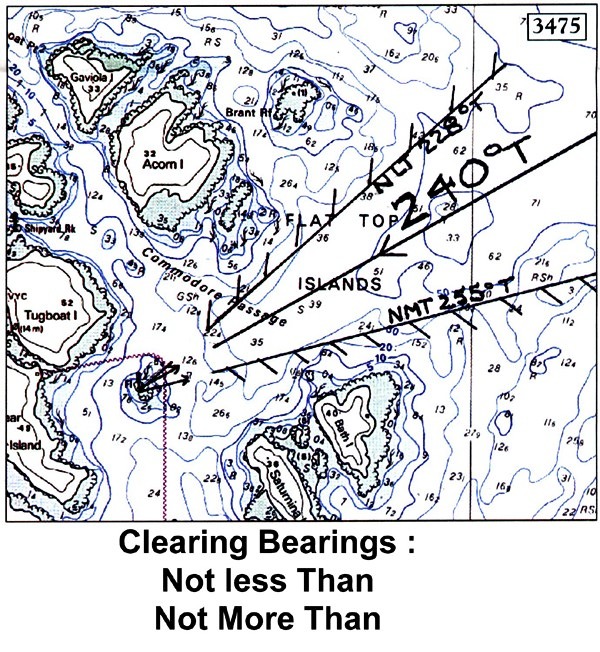
Clearing The Rocks and other channels in the BC coast

Boaters who run aground in the Gulf Islands often misjudge distances at a critical time. In these confined waters, when fixing is impractical, a simpler technique is essential. Without sophisticated electronics, clearing marks and clearing bearings are the answer. You need only a hand-bearing compass and depth sounder.
For example, entering a harbor, you want to stay clear of rocks on your port side. On your chart, it is apparent that when a light and a point of land are aligned, a line extended from them runs clear of the dangers. The light and point of land are clearing marks. As long as you stay inside the clearing line defined by them you are in safe water. If your boat drifts so that the clearing marks come into line you are standing into danger. Alter course away from the clearing line.
Use clearing bearings when clearing marks are not available. Draw a line from a lead mark along a bearing, which will clear the danger. Lead marks are simply conspicuous objects ahead of the boat that provide an "aim point" for the helm and help you determine if you're drifting off track. Stem marks are used when the only reference object is behind you.
Let's put this into practice. You want to pass between rocks on your starboard side and a wreck to port. On a track of 270* heading toward a light ahead that's beyond the dangers, you will remain equidistant from both the rocks and the wreck. Anticipating some current in the area and with no time to plot a fix, you'll want clearing bearings on both sides of your track. Draw a line from the lead mark to pass clear of the rocks on your starboard side. The bearing is 260', so the lead mark must never bear less than 260'. Label this clearing bearing "(not less than) NLT 260*." On the port side, a clearing bearing of 280* keeps you clear of the wreck. Label this one "(not more than) NMT 280*." Any bearing greater than 280' and you risk joining the wreck!
Confused by the "not less than" and "not more than" concept? Try this. Set your parallel rule to a bearing of 255* on the compass rose. Walk it over to the lead mark and you'll see that it passes over the rocks, because it's less than 260*. A bearing of 2850 from the lead mark will intersect the wreck on the port side of your intended track because it's more than 280*.
The value of clearing bearings is best illustrated in the approach to Silva Bay. Currents may set your boat onto the drying reefs off Acorn Island or the rocks near Bath Island. For the approach, you decide on a track of 240* T (True), leading on Tugboat Island Light. A clearing bearing of NLT 228' T will keep you clear of the drying reefs south of Acorn Island.

The rock near Bath Island lies outside a clearing bearing NMT 255* T. All you have to do is aim at Tugboat Island Light on a course of 240 T, and frequently observe this lead mark with your hand. bearing compass. If the bearing decreases, you are being set toward Acorn Island. Immediately alter course to port. Conversely, if the bearing increases you are drifting toward Bath Island. It only takes a few seconds to determine if you are safely within your clearing bearing, and you don't have to leave the helm to plot fixes.
Another important tool for staying out of trouble is your depth sounder. In the majority of Gulf Islands groundings, the sounder wasn't on! Before relying on the depth sounder, take two precautions. First, determine whether the sounder is reading from the bottom of the hull or the bottom of the keel. If the reading is from the hull, you must subtract the keel depth for the correct depth under the keel-a difference of 3 to 4 for many sailboats. Post a warning to this effect, prominently, on or near the instrument. Second, work out the height of the tide in advance, so you can correctly interpret your depth readings. Again, it's a good idea to post the correction.
Frequently checking clearing marks and clearing bearings, along with depth soundings, is a simple and professional navigation technique. Any drift of your vessel will be detected immediately and you can take corrective action early. Navigation in confined waters becomes relaxed and the uncertainty of determining distance is removed. Had the hapless mariners in my Gulf Islands study taken these simple precautions, $87,700 in insurance claims would never have been filed.
-Barrie Jackson, Pacific Yachting & Blue Pacific Yacht Charters,
